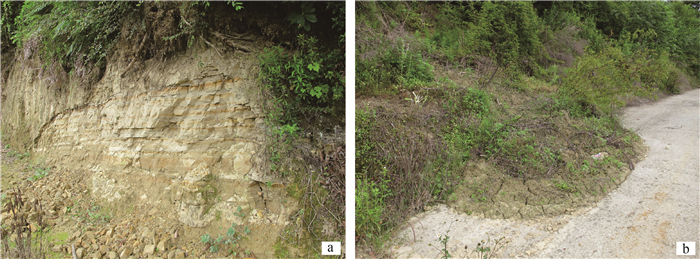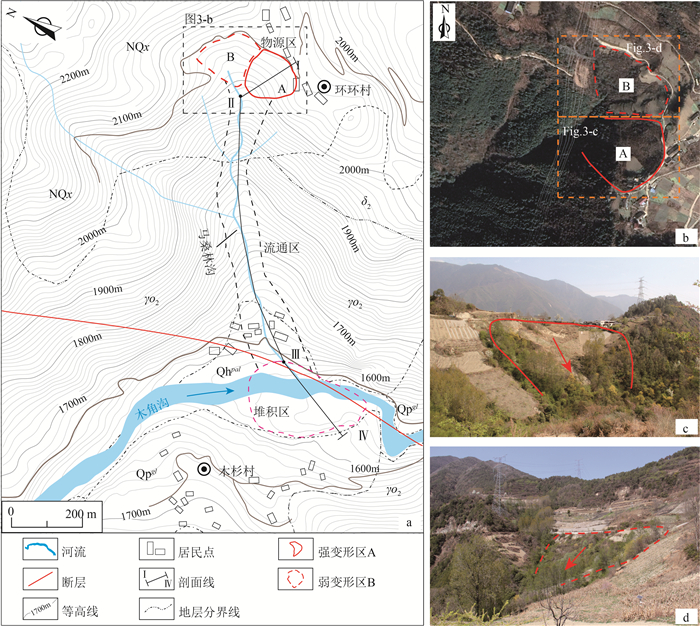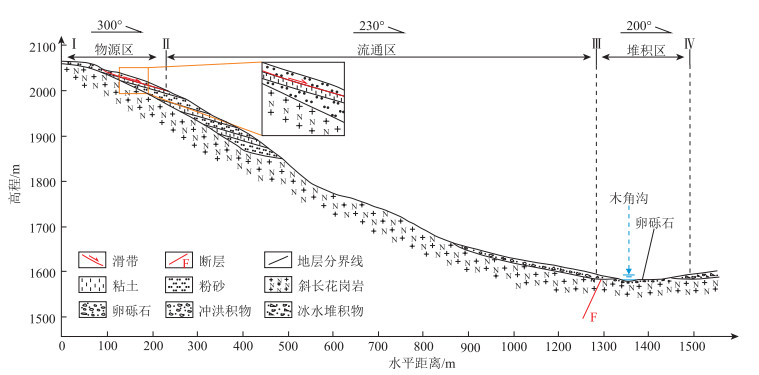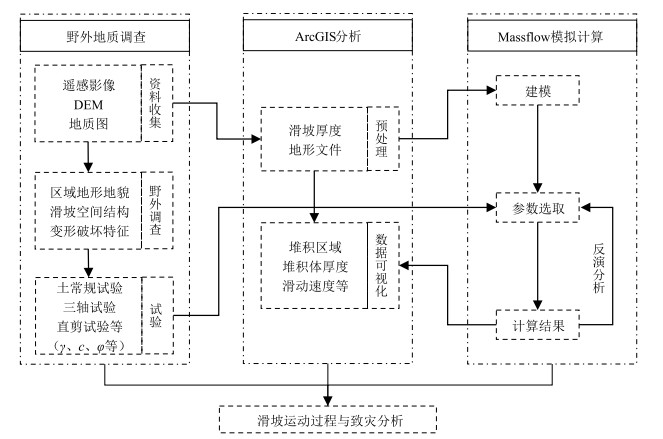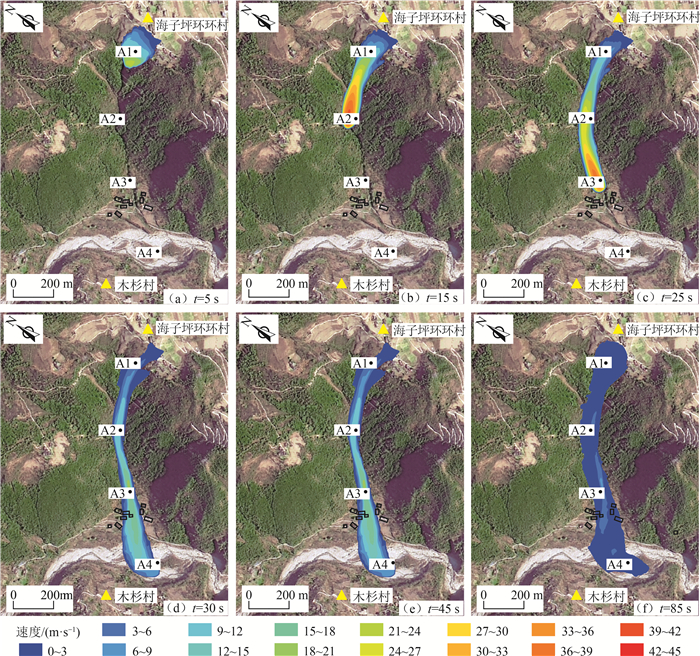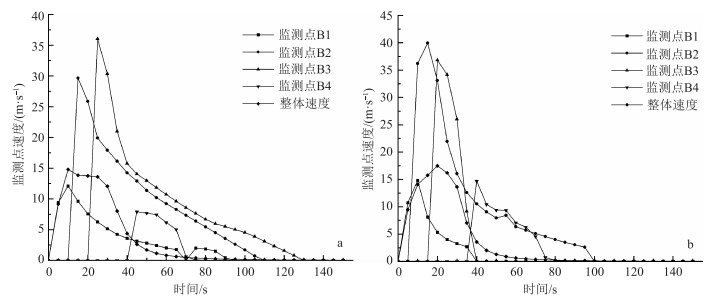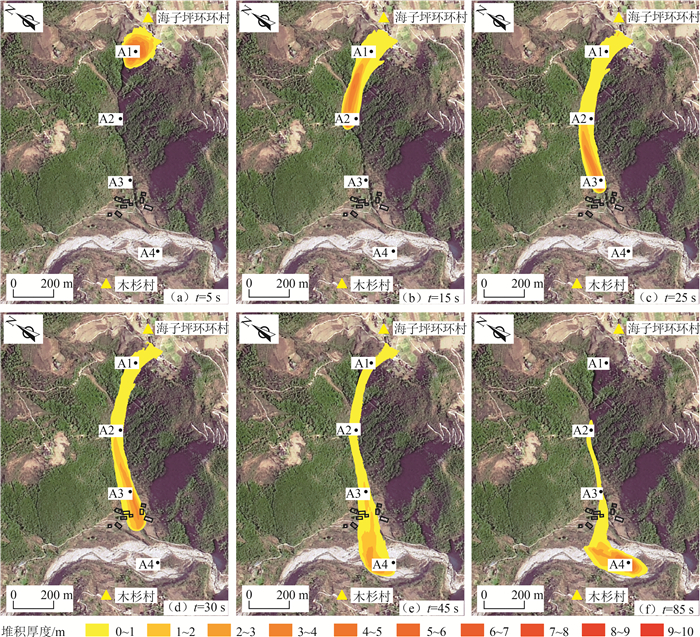Simulation analysis of landslide disaster movement process in Xigeda Formation, Luding County, Sichuan Province
-
摘要:
四川泸定昔格达组以半成岩为主,工程地质特性复杂,在高陡斜坡中常发生浅层蠕滑变形,在强降雨作用下失稳后可转化为泥石流。本文以四川省泸定县海子坪环环村滑坡为例,基于遥感解译、地面调查、数值模拟等方法,对滑坡发育特征、潜在失稳模式和滑坡-泥石流运动过程进行分析。结果表明,环环村滑坡主要发育于昔格达组内,以深度3~5 m的浅层变形为主,整体处于蠕滑变形阶段。滑坡平面上分为强变形区(A区)和弱变形区(B区),体积分别约为5.5×104 m3、5.8×104 m3,在不同降雨条件下,存在仅有A区下滑和A区牵引B区一起下滑并转化为沟道泥石流2种致灾模式。当仅有A区失稳下滑时,最远运动距离可达1325 m,最大堆积厚度为5.2 m,最大运动速度41.6 m/s,滑坡破坏沟口居民区及道路。当A区和B区同时失稳下滑时,最远运动距离可达1345 m,最大堆积厚度为7.7 m,最大运动速度为44.3 m/s,滑体最远能够冲至河流对岸,形成高约3 m的滑坡坝。研究结果对于深化浅层滑坡-泥石流远程致灾效应的认识和防灾减灾具有一定的指导意义。
Abstract:The Xigeda Formation developing in Luding County, Sichuan Province, is mainly composed of semi-diagenetic rocks, which has complex engineering geology properties.Shallow creep deformation of the Xigeda Formation often occurs in the slope with high and steep terrain.It can transform into debris flow after destabilization under the action of heavy rainfall.In this paper, the Huanhuancun landslide in Haiziping developing in the Xigeda Formation was selected as a study case.Based on remote sensing interpretation, field investigation and numerical simulations, we analyzed and calculated the development characteristics of landslides, potential instability modes and the process of landslide-debris flow movement.This study has shown that the Huanhuancun landslide is mainly developed in the Xigeda Formation, mainly in the shallow deformation with a depth of 3~5 m, and is in the creep deformation stage as a whole.The landslide in plane can be divided into strong deformation zone(A) and weak deformation zone(B) with the volume of approximately 5.5×104m3 and 5.8×104m3.Under different rainfall conditions, there are only two forming patterns of disasters: zone A sliding and zone A pulling zone B sliding together and transforming into gully debris flow.When only the zone A slides downslope, the longest movement distance can reach 1325 m, the maximum thickness of deposits is 5.2 m, the maximum velocity is 41.6 m/s, and the sliding body will damage the residential areas and roads.When the zone A and B slides together, the maximum movement distance can reach 1345 m, the maximum thickness of deposits is 7.7 m, the maximum velocity is 44.3 m/s, and the sliding body can rush as far as the other side of the river, forming a landslide dam with a height of about 3 m.The research results have certain guiding significance for deepening the understanding of remote disaster effect of shallow landslide-debris flow and disaster prevention and mitigation.
-
Key words:
- Xigeda Formation /
- soil landslide /
- landslide-debris flow /
- Massflow /
- risk assessment
-

-
表 1 数值模拟参数取值
Table 1. Numerical simulation parameter values
岩土类型 含水率(w)/% 泥石流容重(ρ)/(kg·m-3) 摩擦系数(μ) 湍流系数(ξ)/(m·s-2) 粉质粘土 26 2020 0.1 1000 -
[1] Buser O, Frutiger H. Observed maximum run-out distance of snow avalanches and the determ ination of the friction coefficients μ and ξ[J]. Journal of Glaciology, 1980, 26(94): 121-130. doi: 10.3189/S0022143000010662
[2] Fan X M, Yang F, Subramanian S S, et al. Prediction of a multi-hazard chain by an integrated numerical simulation approach: the Baige landslide, Jinsha River, China[J]. Landslides, 2020, 17(1): 147-164. doi: 10.1007/s10346-019-01313-5
[3] Hürlimann M, McArdell B W, Rickli C. Field and laboratory analysis of the runout characteristics of hillslope debris flows in Switzerland[J]. Geomorphology, 2014, 232: 20-32.
[4] Iverson R M, George D L. Modelling landslide liquefaction, mobility bifurcation and the dynamics of the 2014 Oso disaster[J]. Géotechnique, 2016, 66(3): 1-13.
[5] Nishiguchi Y, Uchida T. Long-runout-landslide-induced debris flow: the role of fine sediment deposition processes in debris flow propagation[J]. Journal of Geophysical Research: Earth Surface, 2022, 127(2).
[6] Ouyang C J, He S M, Tang C. Numerical analysis of dynamics of debris flow over erodible beds in Wenchuan earthquake-induced area[J]. Engineering Geology, 2015, 194: 62-72. doi: 10.1016/j.enggeo.2014.07.012
[7] Ouyang C J, He S M, Xu Q, et al. A MacCormack-TVD finite difference method to simulate the mass flow in mountainous terrain with variable computational domain[J]. Computers & Geosciences, 2013, 52: 1-10.
[8] Ouyang C J, Zhou K Q, Xu Q, et al. Dynamic analysis and numerical modeling of the 2015 catastrophic landslide of the construction waste landfill at Guangming, Shenzhen, China[J]. Landslides, 2017, 14(2): 705-718. doi: 10.1007/s10346-016-0764-9
[9] Poisel R, Preh A, Hungr O. Run out of landslides-continuum mechanics versus discontinuum mechanics models[J]. Geomechanics and Tunnelling, 2008, 1(5): 358-366. doi: 10.1002/geot.200800036
[10] Roslan R, Omar R C, Putri R F, et al. Slope stability analysis using Universal Distinct Element Code(UDEC)method[J]. IOP Conference Series: Earth and Environmental Science, 2020, 451: 012081. doi: 10.1088/1755-1315/451/1/012081
[11] Scaringi G, Fan X M, Xu Q, et al. Some considerations on the use of numerical methods to simulate past landslides and possible new failures: the case of the recent Xinmo landslide(Sichuan, China)[J]. Landslides, 2018, 15(7): 1359-1375. doi: 10.1007/s10346-018-0953-9
[12] Zhu B L, Wu X Y. An analysis of rainfall-Induced landslide in colluvial and eluvial soils overlying Xigeda strata, southwestern Sichuan, China[J]. Advanced Materials Research, 2011, 250/253: 2682-2688. doi: 10.4028/www.scientific.net/AMR.250-253.2682
[13] 柴春阳. 雅泸高速文武坡喇嘛溪沟重力侵蚀及其对工程影响研究[D]. 西南交通大学硕士学位论文, 2008.
[14] 陈晓清. 滑坡转化泥石流起动机理试验研究[D]. 西南交通大学博士学位论文, 2006.
[15] 邓建辉, 陈菲, 尹虎, 等. 泸定县四湾村滑坡的地质成因与稳定评价[J]. 岩石力学与工程学报, 2007, 26(10): 1945-1950. doi: 10.3321/j.issn:1000-6915.2007.10.001
[16] 丁文富, 张广泽, 宋章. 成昆铁路昔格达地层工程地质特性及对策研究[J]. 铁道工程学报, 2017, 34(4): 1-5. doi: 10.3969/j.issn.1006-2106.2017.04.001
[17] 段学良, 马凤山, 郭捷, 等. 基于Massflow模型的西藏仁布杰仲沟泥石流运动特征分析[J]. 中国地质灾害与防治学报, 2019, 30(6): 25-33.
[18] 郭长宝, 倪嘉伟, 杨志华, 等. 川西大渡河泸定段大型古滑坡发育特征与稳定性评价[J]. 地质通报, 2021, 40(12): 1981-1991. doi: 10.12097/j.issn.1671-2552.2021.12.001
[19] 何军. 大渡河干海子堰塞堆积体成因机制及稳定性研究[D]. 成都理工大学硕士学位论文, 2009.
[20] 黄绍槟, 吉随旺, 朱学雷, 等. 西攀路昔格达地层滑坡分析[J]. 公路交通科技, 2005, 6(S1): 41-44.
[21] 蒋复初, 吴锡浩, 肖华国, 等. 四川泸定昔格达组时代及其新构造意义[J]. 地质学报, 1999, 73(1): 1-6. doi: 10.3321/j.issn:0001-5717.1999.01.001
[22] 金文祥. 西藏定日县达仓沟泥石流危险性评价[D]. 成都理工大学硕士学位论文, 2019.
[23] 李后强, 丁晶, 艾南山. 攀西地区滑坡发育的理论研究[J]. 中国地质灾害与防治学报, 1997, 8(1): 13-17.
[24] 李树德, 曾思伟. 论泥石流的另一种类型——滑坡型泥石流——以甘肃刘家堡泥石流为例[J]. 水土保持学报, 1988, 2(4): 66-71.
[25] 李文杰, 冯文凯, 魏昌利, 等. 地形对泸定县兴隆镇群发性滑坡型泥石流的影响分析[J]. 水利与建筑工程学报, 2016, 14(1): 149-154.
[26] 梁馨月, 曾璐, 葛永刚, 等. 川西高原鲜水河断裂带炉霍—道孚段泥石流分布特征[J]. 地质通报, 2021, 40(12): 2061-2070. doi: 10.12097/j.issn.1671-2552.2021.12.009
[27] 林喜珊. 流动型黄土滑坡数值模拟研究[D]. 兰州大学硕士学位论文, 2020.
[28] 刘春, 范宣梅, 朱晨光, 等. 三维大规模滑坡离散元建模与模拟研究——以茂县新磨村滑坡为例[J]. 工程地质学报, 2019, 27(6): 1362-1370.
[29] 刘春, 张晓宇, 许强, 等. 三维离散元模型的滑坡能量守恒模拟研究[J]. 地下空间与工程学报, 2017, 13(S2): 698-704.
[30] 刘恒一. 攀西地区的滑坡和泥石流的关系[J]. 水土保持通报, 1987, 7(1): 21-26.
[31] 刘惠军, 聂德新. 昔格达地层研究综述[J]. 地球科学进展, 2004, 19(S1): 80-82.
[32] 孟祥磊. 昔格达地层软弱围岩隧道变形机理及支护技术研究[D]. 西南交通大学硕士学位论文, 2015.
[33] 彭建兵, 王启耀, 庄建琦, 等. 黄土高原滑坡灾害形成动力学机制[J]. 地质力学学报, 2020, 26(5): 714-730.
[34] 秦宇龙, 吴建亮, 詹涵钰, 等. 川西甘孜地区活动断裂与地质灾害分布相关性探讨[J]. 地质力学学报, 2021, 27(3): 463-474.
[35] 施云云. 大渡河泸定段海子坪昔格达组的宇生核素等时线埋藏测年及地貌意义[D]. 南京师范大学硕士学位论文, 2020.
[36] 铁永波, 张宪政, 卢佳燕, 等. 四川省泸定县Ms6.8级地震地质灾害发育规律与减灾对策[J]. 水文地质工程地质, 2022, 49(6): 1-12.
[37] 王士革. 山坡型泥石流的危害与防治[J]. 中国地质灾害与防治学报, 1999, 10(3): 46-51.
[38] 王志杰, 周平, 徐海岩, 等. 昔格达地层隧道围岩灾变特征及致灾因子研究[J]. 铁道工程学报, 2017, 34(11): 67-75.
[39] 文丽娜, 朱学雷, 白志勇, 等. 西攀高速公路新九地区昔格达地层岩土特性[J]. 公路, 2005, 7(7): 145-148.
[40] 吴焕恒. 西昌某边坡昔格达组地层蠕变试验及其边坡蠕变变形分析[D]. 西南交通大学硕士学位论文, 2010.
[41] 吴瑞安, 张永双, 郭长宝, 等. 川西松潘上窑沟古滑坡复活特征及危险性预测研究[J]. 岩土工程学报, 2018, 40(9): 1659-1667.
[42] 熊坤勇, 范宣梅, 杨帆, 等. 九寨沟九寨天堂泥石流沟特征分析与模拟预测[J]. 科学技术与工程, 2020, 20(27): 10989-10995.
[43] 阳清青, 余秋兵, 张廷斌, 等. 基于GDIV模型的大渡河中游地区滑坡危险性评价与区划[J]. 中国地质灾害与防治学报, 2023, 34(5): 130-140.
[44] 杨智勇, 吉锋. 大渡河干海子滑坡稳定性研究[J]. 防灾减灾工程学报, 2011, 31(2): 201-206.
[45] 殷邦民. 尼续村高速远程滑坡流态化堆积与运动学特征研究[D]. 西南交通大学硕士学位论文, 2020.
[46] 张明, 胡瑞林, 殷跃平, 等. 滑坡型泥石流转化机制环剪试验研究[J]. 岩石力学与工程学报, 2010, 29(4): 822-832.
[47] 张永双, 曲永新. 硬土-软岩的厘定及其判别分类[J]. 地质科技情报, 2000, 19(1): 77-80.
[48] 张永治. 攀西地区昔格土综述[J]. 攀枝花大学学报, 1995, 12(2): 75-78.
[49] 钟成, 范德平. 川南昔格达岩组工程地质特性研究[J]. 四川水力发电, 2012, 31(1): 97-99.
[50] 周罕, 曹平, 张科. 昔格达组黏土岩和粉砂岩现场直剪试验研究[J]. 中南大学学报(自然科学版), 2014, 45(10): 3544-3550.
[51] 周平, 王志杰, 侯伟名, 等. 昔格达地层隧道局部浸湿失稳特征及突变预测研究[J]. 岩土工程学报, 2020, 42(3): 503-512.
[52] 周琪, 许强, 周书, 等. 基于数值模拟的突发型黄土滑坡运动过程研究——以黑方台陈家8#滑坡为例[J]. 山地学报, 2019, 37(4): 528-537.
[53] 周云金, 曾联明. 红格提水工程二级泵站昔格达地层特性及坡体变形成因分析[J]. 水电站设计, 2000, 16(2): 61-65.
-




 下载:
下载:
